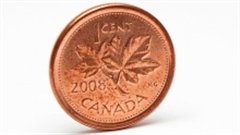The penny, the copper one cent piece, of Canadian currency was phased out in February 2013, as a cost-cutting measure. It cost the Royal Canadian Mint more to make, than the coin was worth.

Since that time in Canada, cash transactions have been rounded up or down to the nearest nickel — so a total of $1.01 and $1.02 would be rounded down to $1, while $1.03 and $1.04 would be rounded up to $1.05.
In the ensuing year, Roger Guitar, of Montreal, kept track of his daily transactions to see whether he was gaining or losing as a result of the change. Now he knows!
89 cents richer
365 cash transactions later, the man from Montreal’s South Shore finds himself 89 cents ahead.
In an interview with CBC, Roger Guitar shared his figures, “Here, for example in April, I was up five cents; in February I was minus-23 cents. Here, we bought some flowers for $11.48. They charged me $11.50, so I lost two cents.”
Roger Guitar said, however, he’d like to know how it worked for retailers. So CBC sent a reporter to find out.
Beware $1.03
When Sophie Tremblay visiter a local convenience store and inquired, Dong Sheng Wang, the owner, said he’s too busy to calculate the result. “I think it’s the same, said Wang. “Sometimes I lose. Sometimes I really win.” But Wang said he knows some store owners who fix their prices to use rounding to their advantage. “My friend tells me if you set up the price good maybe you can make $300, $200 a year,” he said.
As for Roger Guitar, he concludes most businesses don’t round to make money and it all adds to plus or minus a dollar. He also sent his study to Canada’s Finance Minister who thanked him for his calculations.







For reasons beyond our control, and for an undetermined period of time, our comment section is now closed. However, our social networks remain open to your contributions.